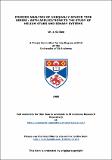Files in this item
Fourier analysis of unequally-spaced time series : with applications to the study of helium stars and binary systems
Item metadata
| dc.contributor.advisor | Hilditch, R. W. | |
| dc.contributor.advisor | de Groot, M. | |
| dc.contributor.author | Skillen, W. J. I. (Ian) | |
| dc.coverage.spatial | 412 p. | en_US |
| dc.date.accessioned | 2017-06-28T12:57:34Z | |
| dc.date.available | 2017-06-28T12:57:34Z | |
| dc.date.issued | 1986 | |
| dc.identifier | uk.bl.ethos.571492 | |
| dc.identifier.uri | https://hdl.handle.net/10023/11105 | |
| dc.description.abstract | The application of the discrete Fourier transform to the determination of the frequency content of unevenly-sampled astronomical time series is discussed, and an interactive computer package which incorporates a variety of power-spectrum and time-domain techniques is described. A frequency analysis of the light curves of two hot, extreme helium stars, BD-9°4395 and HD160641, shows that their photometric variability is caused by non-radial pulsation. Spectroscopic evidence in support of non-uniform mass loss is presented for BD-9°4395. Spectroscopic and photometric observations of two early-type eclipsing binary systems, AL Sculptoris and DM Persei, have been analysed to yield their absolute dimensions. AL Scl is found to be a detached system in which both components rotate faster than synchronism. The origin of distortions in its light curve is unclear. DH Per is shown to be part of a triple system in which the third component is most probably a late-B star in a 98-day orbit with a semi-major axis of 0.9 A.U. The binary system is confirmed to be semi-detached and to have evolved through a phase of rapid mass transfer. DH Per joins a small group of massive, semi-detached systems whose characteristics differ significantly from the classical Algols, and which may result from case-A, mass-transfer processes. Spectroscopic and photometric observations of the F4V star HD123058 do not support the hypothesis that it is a binary system. Broad lines in its spectrum are attributed to a somewhat enhanced rotation rate, and the star is shown to be essentially unevolved. The derivation of the equation of condition in Sterne's rigorous method for the analysis of the spectroscopic elements of binary systems, and its modification for incorporating observed times of minimum light into the adjustment of the elements, are outlined. A computer code for the determination of orbital elements according to this scheme is described. | en_US |
| dc.language.iso | en | en_US |
| dc.publisher | University of St Andrews | |
| dc.subject.lcc | QB821.S6 | |
| dc.subject.lcsh | Double stars | en |
| dc.title | Fourier analysis of unequally-spaced time series : with applications to the study of helium stars and binary systems | en_US |
| dc.type | Thesis | en_US |
| dc.contributor.sponsor | Science and Engineering Research Council (SERC) | en_US |
| dc.type.qualificationlevel | Doctoral | en_US |
| dc.type.qualificationname | PhD Doctor of Philosophy | en_US |
| dc.publisher.institution | The University of St Andrews | en_US |
This item appears in the following Collection(s)
Items in the St Andrews Research Repository are protected by copyright, with all rights reserved, unless otherwise indicated.

